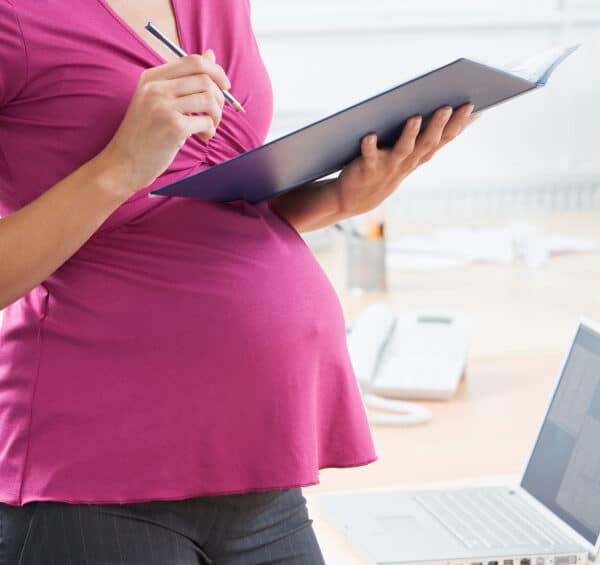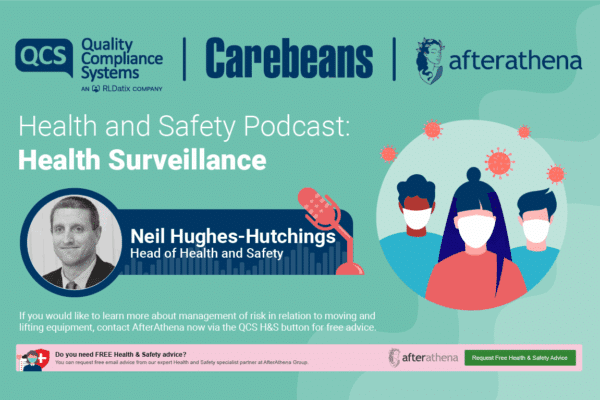
Some of the potential health problems that can occur, be made worse or impact on the work activity are:
- Injuries arising from moving and handling – less weight can be carried
- Impairment of dexterity, agility, co-ordination, speed of movement, reach or balance
- Over-tiredness or pain due to long periods of standing
- Shocks; regular exposure to vibration or excessive movement
- Miscarriage
- Premature birth
- Damage to unborn foetus; birth defects
- Development of varicose veins
- Stress and high blood pressure
- Severe morning sickness; frequent visits to the toilet
- Transmission to baby of biological hazards, giving rise to serious consequences
- Infection
- Increased risk of accidents due to fatigue and mental stress
Pregnancy risk assessment – review periods
An initial pregnancy risk assessment should be completed once the employee informs her employer that she is pregnant, with written notification of pregnancy. The first review should be completed on the second trimester (3-6 months) or earlier if required. The second review should be completed on the third trimester (6-9 months) or earlier if required. The third review should be undertaken prior to return to work, and the fourth following return to work. If there is a significant change in the worker’s health then a further review is required. Employees should inform their employer by written notification at least 15 weeks before the beginning of the week the child is due or, if the pregnancy is initially unknown, as soon as possible.
Legislative requirements
The following specific laws relating to new and expectant mothers at work cover female employees of childbearing age and expectant or new mothers, including those who are breastfeeding. These are:
- The Management of Health and Safety at Work Regulations 1999 (MHSW) which require employers to protect the health and safety of new and expectant mothers;
- The Workplace (Health, Safety and Welfare) Regulations 1992 which require employers to provide suitable rest facilities;
- The Equality Act 2010 which provides protection to pregnant women and those on maternity leave against discrimination. Depending on the circumstances, this can include failing to carry out a risk assessment under MHSW regarding a pregnant worker.
Regulation 16 of the Management of Health and Safety at Work Regulations 1999 places a duty on employers to carry out a risk assessment in respect of new or expectant mothers.
Section 16 covers:
(a) the workers working in an undertaking include women of child-bearing age; and
(b) the work is of a kind which could involve risk, by reason of her condition, to the health and safety of a new or expectant mother, or to that of her baby, from any processes or working conditions, or physical, biological or chemical agents, including those specified in Annexes I and II of Council Directive 92/85/EEC(1) on the introduction of measures to encourage improvements in the safety and health at work of pregnant workers and workers who have recently given birth or are breastfeeding,
(c) If it is not reasonable to alter the working conditions or hours of work, or if it would not avoid such risk, the employer shall, subject to section 67 of the 1996 Act suspend the employee from work for so long as is necessary to avoid such risk.
Pregnancy hazards and risks
The following are examples of areas to include in the risk assessment when determining what controls are required to manage the environment and working conditions that potentially could cause risk to a pregnant worker or an unborn child.
- Hazardous Substances
- R46 May cause heritable genetic damage
- R47 May cause birth defects
- R60 May impair fertility
- R61 May cause harm to the unborn child
- R62 Possible risk of impaired fertility
- R63 Possible risk of harm to the unborn child
- R64 May cause harm to breast-fed babies
- Mercury and mercury derivatives
- Antimitotic (cytotoxic) drugs
- Some pesticides
- Carbon monoxide
- Lead and lead derivatives capable of being absorbed by the body.
- Biological Agents
- Exposure to certain bacteria and viruses presents a risk
- Exposure to infected animals
- Examples: rubella, chickenpox, slapped cheek disease
- Manual handling
- Potentially at risk to moving and handling injuries due to hormonal changes
- Caesarean section – possible temporary limitation to full range of movement
- Posture or ergonomic consideration
- Agility, dexterity, co-ordination, ease and speed of movement may be impaired, particularly in the last trimester
- Dizziness, fainting and fatigue
- DSE
- DSE risk assessment review when reviewing pregnancy risk assessment
- Higher risk of thrombosis if constantly sitting
- Avoid standing for long periods of time
- Increased size, reduced mobility, dexterity, low back ache
- Travelling to and from work
- Car – driver risk assessment – additional increased fatigue, vibrations, static posture, road traffic collisions
- Tube – bump badge allows members of the public to be aware that she is pregnant and to offer their seat, particularly important when train and tubes are at peak hours
- Change of work times so pregnant worker can travel after rush hour am and before rush hour pm
- Advise worker to carry means of hydration and light, healthy snacks in case of tube/train breakdown
- Charged mobile phone for emergencies
- Work at Height
- Risk of fainting and high blood pressure
- Use of ladders or step ladders
- Risk of falls
- Lone Working
- Charged mobile phone
- Panic alarms
- Buddy system
- Slip, trip falls
- Uneven floor, trailing cables
- Fire
- Review fire risk assessment – speed of mobility during last trimester
- Extremes of heat and cold
- May pose a risk to the unborn child
- Physical Agents such as vibration
- Avoid excessive exposure
- Welfare
- Rest room facilities – urgency and more frequent need
- Regular breaks
- Rest area in which to sit or lie down
- Regular rehydration
- Breast milk expression on return to work
- Stress at Work
- Vulnerable to occupational stressors
- Physiological and hormonal changes
- Support with adjustment to hours of work, workload, work demands and role
- Violence or challenging behaviour
- Working in potentially violent situations
- Shift work
- Nausea on early shift work
- Night work
- Fatigue may be increased
- Excessive noise
- Leads to stress and high blood pressure
- Ionising radiation Non-ionising radiation
- Exposure and risk to the unborn child
- Confined spaces
- Increased abdominal size
- PPE and uniform
- Review the need for bigger sizes
Record and review
The pregnancy risk assessment should be completed with the worker as she may have additional information from her midwife. It should be documented and a copy made available to the pregnant worker and their manager, who must be aware of any changes required.
QCS policies
QCS has guidance and policies for documenting pregnancy risk assessment to support your service in meeting the requirements of health and safety.
References
gov.uk – The Management of Health and Safety at Work Regulations 1999






